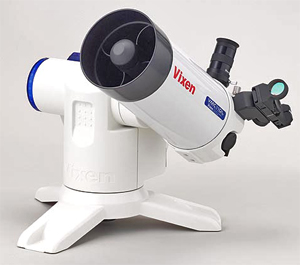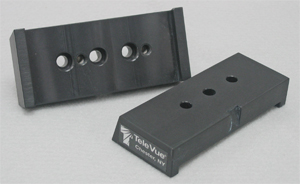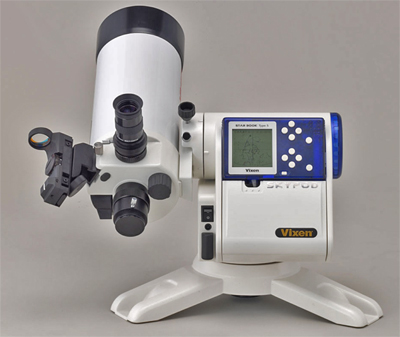Vixen Distribution
![]() History
History ![]() News
News ![]() Notes & Literature
Notes & Literature ![]() Overview
Overview ![]() Pricing
Pricing ![]() Products
Products
![]() Mounts
Mounts
![]() Telescopes
Telescopes
![]() Quality Control
Quality Control
![]() Service or Repair
Service or Repair

VIXEN "SKYPOD" ALTITUDE AZIMUTH "GO TO" MOUNT
 This product is not yet imported by Vixen North America. In time Vixen may decide to import and promote this through their three preferred E-Tailers. In the meantime, Company Seven offers this product as a service to our customers only.
This product is not yet imported by Vixen North America. In time Vixen may decide to import and promote this through their three preferred E-Tailers. In the meantime, Company Seven offers this product as a service to our customers only.
![]() Overview: What is the Skypod and when do we recommend it?
Overview: What is the Skypod and when do we recommend it?
The Skypod is a revolutionary portable alt-azimuth computer controlled "Go To" mount that evolved from the SPHINX SX compact and SPHINX SXW "Go To" German Equatorial Mounts and their STAR BOOK SPHINX Mount Control and Portable Planetarium System. It is the first compact Alt-Az mount with computer control enabling the operator to direct the mount to find a variety of astronomical objects and then track them as the Earth rotates that also provides the capability to quickly interchange telescopes, cameras, etc. Skypod provides good portability combined with ease of use and versatility.
Right: Vixen Skypod with tabletop tripod and VMC110L telescope (60,349 bytes)
Click on the image to see enlarged view (111,288 bytes).
The Skypod system consists of these components:
- Skypod Head
- Star Book Type S Control Panel
- Tabletop or Field Tripod
- Quick Release Dovetail Plate
- Power Source (internal or external)
 Skypod was first introduced overseas in December 2005, with deliveries starting in May 2006. It is initially promoted for sale only with the Vixen VMC110L, a 110 mm (4.33 inch) aperture modified Cassegrain f/9.4 optical tube assembly as shown on these illustrations. To give some sense of scale the VMC110L is 125 mm (4.92 inch) diameter and 360 mm (14.7 inch) in length. The VMC110L is intriguing in its own right with interesting features including curved vane Secondary Mirror Spider to reduce diffraction effects, and a correcting meniscus lens just ahead of the Secondary Mirror as its larger cousins the VMC200L and VMC260L incorporate. The Skypod can be used with many other compact astronomical telescopes including our TeleVue 76, TeleVue 85, Leica, Orion 80 ED. In time we believe Vixen may offer the mount for sale separately.
Skypod was first introduced overseas in December 2005, with deliveries starting in May 2006. It is initially promoted for sale only with the Vixen VMC110L, a 110 mm (4.33 inch) aperture modified Cassegrain f/9.4 optical tube assembly as shown on these illustrations. To give some sense of scale the VMC110L is 125 mm (4.92 inch) diameter and 360 mm (14.7 inch) in length. The VMC110L is intriguing in its own right with interesting features including curved vane Secondary Mirror Spider to reduce diffraction effects, and a correcting meniscus lens just ahead of the Secondary Mirror as its larger cousins the VMC200L and VMC260L incorporate. The Skypod can be used with many other compact astronomical telescopes including our TeleVue 76, TeleVue 85, Leica, Orion 80 ED. In time we believe Vixen may offer the mount for sale separately.
Left: Vixen Skypod with tabletop tripod and VMC110L telescope (40,818 bytes)
Click on the image to see enlarged view 75,613 bytes).
Skypod's drive mechanism incorporates two identical 70 tooth worm gear drive sets each driving one platform left or right (azimuth), while the other drives the fork up and down (elevation); hence the term Alt-Az for short. The motors can drive the axes along the full 360 degrees up down or left and right. Skypod is controlled by the Star Book Type S, a compact personal planetarium computer with a graphical user interface (GUI) shown on the 2.6-inch monochrome LCD display. The buttons to the right side of the screen correspond to commands shown on the screen displays. The Star Book Type S is a simpler version of the STARBOOK. Just set up the hardware, turn it on, index the mount to the night sky, select then your target on the screen, click the "GOTO" button and then the mount can point the attached telescope or camera to celestial objects automatically. The display shows where the telescope is pointing with a simple chart of the area of sky and display of pointing coordinates on the screen. With its driven gears and computer control, once set up then the Star Book Type S controller provides the user access any area of sky including zenith, and then precisely track a celestial object across the sky. There is no need to touch the telescope after it is set up and the mount is initialized. In fact since this is an open loop control system any manual override will confuse the computer. Furthermore, the Star Book Type S can be removed from the dock and used as a portable reference tool without the mount. The GUI is easy to learn resembling many of the popular portable gaming computers - simply ask any ten year old to help if you ever need it.
With the Star Book Type S and the fully enclosed gear drive and motors it a simple matter to set up the Skypod and then slew at speeds up to 3-¾ degrees per second from one target to another and then track quietly while sharing the telescope with friends and family. Being so compact and easy to use it can be a great teaching tool for instructors who are nervous about not being embarrassed by their lack of conventional navigation skills. Skypod is designed for foremost for easy visual astronomical use however, it does incorporate some features to facilitate astrophotography and CCD imaging of its more sophisticated cousins. While future firmware updates will add further capabilities to the Skypod. When one looks at how some amateurs accomplished good results with film and even the most simple motorized platforms like the Astro-Kit of the 1980's, one can only imagine what may be done with the Skypod!
For wide sky imaging or piggyback photography we would recommend optional hardware or techniques to deal with issues of field rotation. The telescope can traverse up to directly overhead, and down limited only by those longer telescope optical tubes which might reduce the depression angle, and so in these cases we recommend the use of a conventional Field Tripod possibly even with the optional Half Pier extension. The head assembly is attached onto a tripod by means of a hand knob.
 A telescope is installed onto the Skypod by means of an optional Dovetail Plate which slips into the Saddle on the elevation fork tine. This works well with most telescopes that incorporate either a straight through view orientation and this will work fine with telescope optical tubes that are provided with mounting rings. However, some telescopes that position the telescope eyepiece at ninety (90) degrees to the optical axis and that also have no provision for rotation may be incompatible with the Skypod. Please contact Company Seven if you have any questions.
A telescope is installed onto the Skypod by means of an optional Dovetail Plate which slips into the Saddle on the elevation fork tine. This works well with most telescopes that incorporate either a straight through view orientation and this will work fine with telescope optical tubes that are provided with mounting rings. However, some telescopes that position the telescope eyepiece at ninety (90) degrees to the optical axis and that also have no provision for rotation may be incompatible with the Skypod. Please contact Company Seven if you have any questions.
Left: Skypod Saddle shown with optional Dovetail Plate AM-AD-2661 installed on Porta Mount Saddle for example (48,708 bytes)
Click on the image to see enlarged view (101,780 bytes).
The Vixen Dovetail Plate AM-AD-2661 is one of the plates we can recommend to install most common small reflecting and refracting telescopes that employ two separate mounting rings. One ring is attached onto each end of the AM-AD-2661 to support the telescope. The mounting rings are loosened enough to permit sliding the telescope lengthwise back and forth until a reasonable balance is achieved, then the rings are tightened. The AM-AD-2661 is cast aluminum painted to match the Skypod mount, Porta Mount, and other popular Vixen German Equatorial Mounts.
 Company Seven also offers an adapter plate to facilitate the installation of telescopes made by TeleVue Optics, Inc. onto the Skypod. This plate attaches onto a TeleVue telescope's Ring Mount and makes it easy to move the telescope from TeleVue's Telepod or Gibraltar mounts to the Skypod mount, or from the Skypod onto Vixen Equatorial German mounts. When one lays the plate over the cradle of the Telepod head, Gibraltar Mount, Skypod and other similar mounts you can center it so that a Wing Nut Bolt can come up from below. It also makes it a simple matter to install the telescope onto the Vixen German mounts that incorporate the dovetail plate mechanism. The plate is machined of aluminum stock, and is black anodized. This Plate is part number AVX-1011.
Company Seven also offers an adapter plate to facilitate the installation of telescopes made by TeleVue Optics, Inc. onto the Skypod. This plate attaches onto a TeleVue telescope's Ring Mount and makes it easy to move the telescope from TeleVue's Telepod or Gibraltar mounts to the Skypod mount, or from the Skypod onto Vixen Equatorial German mounts. When one lays the plate over the cradle of the Telepod head, Gibraltar Mount, Skypod and other similar mounts you can center it so that a Wing Nut Bolt can come up from below. It also makes it a simple matter to install the telescope onto the Vixen German mounts that incorporate the dovetail plate mechanism. The plate is machined of aluminum stock, and is black anodized. This Plate is part number AVX-1011.
Right: two AVX-1011 Adapter Plates shown to illustrate top and bottom (34,803 bytes)
Click on the image to see enlarged view (94,037 bytes).
Company Seven recommends the Skypod to accommodate payloads including:
- telescopes weighing up to about 11 lbs. / 5 kg, this can include
- Reflecting telescopes of up to about 150 mm *
- Refracting telescopes up to about 100 mm aperture *
- Catadioptric telescopes of up to about 150 mm *
* there are factors acting upon a mount affecting its suitability including: payload weight and length (torque), payload area and profile exposed to winds, desired tracking accuracy, tripod resonance's, etc. What are most important to the user is how rigidly the mount holds the payload, how smoothly it tracks, and how well it overcomes the moment imparted by the load. The final operating weight put onto a mount can also depend on how the instrument is to be accessorized.
Skypod mount is a suitable choice for many of our popular compact telescopes. It is lightweight, easy to set up and use. However, for uses in freezing or below climates then the Star Book Type S needs to be kept insulated or warmed by a third party heater. In much lower temperatures the lubricants in the mount will draw higher current and strain the motors, the backlit monochrome LCD panel will diminish and in time will not operate. As long as you are in above freezing conditions (where most people take vacations) then feel free to pack your Skypod!
The Skypod is heavier and more complicated to set up and use than simple Alt azimuth mounts, and so for birding and nature watching you will prefer a more conventional mount possibly the Porta Mount. And if you have no power then the mount is useless, so plan on contingencies - pack an extra eight "AA" batteries for every few nights of observing, a power adapter cord to operate off wall current (GFCI protected outlet) or a portable 12 volt DC power supply.
![]() Skypod Features and Specifications
Skypod Features and Specifications
 Right: Vixen Skypod showing the Star Book Type S console in its dock (66,142 bytes).
Right: Vixen Skypod showing the Star Book Type S console in its dock (66,142 bytes).
Click on the image to see enlarged view (121,866 bytes).
- "Go To" control with integrated star map and LCD monitor
- Cirrus Logic CS89712 32 bit RISC processor for fast computing speed (as on STAR BOOK)
74 MHz ARM720TDMI core performance matches that of a 100-MHz Intel Pentium based PC - Twisted Nematic 2.6 inch (66 mm) Monochromatic LCD display
- Resolution of 160 x 160 (25,600 pixels)
- Panel brightness and contrast are adjustable
- Integrated audio speaker with volume control
- Port connecting Star Book Type S to Mount is Modular 8 pin (RJ45) with straight through wiring (pin 1 to 1 etc.)
- Innovative and intuitive easy to navigate GUI menu structure
- Automated target acquisition and tracking
- Continuously updated position and coordinates of object in 0.1 (arc minute) increment
- Database contains 22,725 objects, more than enough to keep you looking for years to come
- Standard LAN Port 10 BASE-T Ethernet Port for fast communication directly with a PC by means of an Ethernet Crossover Cable and for firmware updates
- LAN Port communicates with a network via a Ethernet Cable into a Hub or Router
- LAN Port communicates with a directly with a PC by means of an Ethernet Crossover Cable
- Firmware is upgradable by the user so that it will be possible to add new free or payware features including Periodic Error Correction, optional Backlash Compensation, and compatibility with most autoguiding CCD systems.
- Modular 6 pin (RJ12) Autoguider Port. By changing in internal dip switch can be configured to operate as a conventional SBIG TIC compatible port or with the Vixen AGA-1 autoguider.
- Battery Holder included, requires eight 1.5 volt alkaline or lithium batteries, 6V 0.2 Amp
- Endurance about eight (8) hours with alkaline batteries at 68° F (20° C)
- External Power suggested is 12 Volt DC 0.5 Amp
- Power Jack 1.7 mm diameter EIAJ RC5320A
- Fastest slewing mode 900X Sidereal
- CR-2032 internal Clock battery, lasts about one year and is easily replaced
- Operating temperature range from 32 to 104° F (0 to 40° C)
- Dimensions: 3.35 inches / 85 mm L x 5.28 inch / 134 mm W x 1.5 inch / 35 mm thick
- Weight 5.8 oz. / 165 g (without batteries)
- Provided with well written, illustrated manual (in English)
-
Stars: 17,635 brighter than Magnitude 7.0
Messier Objects: 110
NGC & IC catalog objects: 4,980 brighter than Magnitude 14.0
Planets, Moon, and Sun
Vixen Skypod Head Features and Specifications
- Eight (8) speeds up to 500 / 900 X Sidereal rates of slewing.
- Easy set up
- Quick Release Dovetail Saddle facilitates setup or take down, or change of instruments
- Head Dimensions: 8.3 inch (210 mm) W x 7.9 inch (200 mm) L x 7.5 inch (19.9 mm) H
- Mount Weight: 9.24 lbs / 4.2 kg
- Payload rating: 11 lbs / 5 kg
- Elevation Axis incorporates 70 tooth Worm Gear Set
- Rotation Axis incorporates 70 tooth Worm Gear Set
- Provided with well written, illustrated manual (in English)
Specifications and availability subject to change
Contents Copyright 2006 Company Seven & Vixen Co. All Rights Reserved


